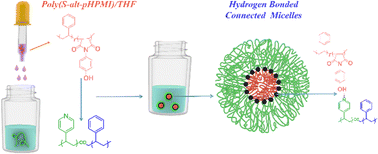Construction of micelles and hollow spheres via the self-assembly behavior of poly(styrene-alt-pHPMI) copolymers with poly(4-vinylpyridine) derivatives mediated by hydrogen bonding interactions†
Abstract
This study describes the preparation of hydrogen bonding connected micelles, consisting of a poly(styrene-alt-(para-hydroxyphenylmaleimide)) [poly(S-alt-pHPMI)] core and a poly(4-vinylpyridine) (P4VP) derivative shell in a selective solvent. The aim was to modify hydrogen bonding interaction sites at the core/shell interface by synthesizing P4VP derivatives in three different sequences, namely, P4VP homopolymers, PS-co-P4VP random copolymers, and block copolymers. TEM images showed the successful self-assembly of poly(S-alt-pHPMI)/PS-co-P4VP inter-polymer complexes into spherical structures. To dissolve the core structures, 1,4-dibromobutane was used as a cross-linking agent to tighten the PS-co-P4VP shell. The morphologies, particle sizes, hydrogen bonding, cross-linking reaction, and core dissolution were confirmed by TEM, DLS, FTIR, and AFM analyses. Poly(S-alt-pHPMI)/PS41-r-P4VP59 hydrogen bonding connected micelles, cross-linked micelles, and hollow spheres were larger and more irregular than poly(S-alt-pHPMI)/P4VP inter-polymer complexes due to the random copolymer architecture and the decrease in intermolecular hydrogen bonds. However, poly(S-alt-pHPMI)/PS68-b-P4VP32 resulted in rod- or worm-like structures after core dissolution.



 Please wait while we load your content...
Please wait while we load your content...